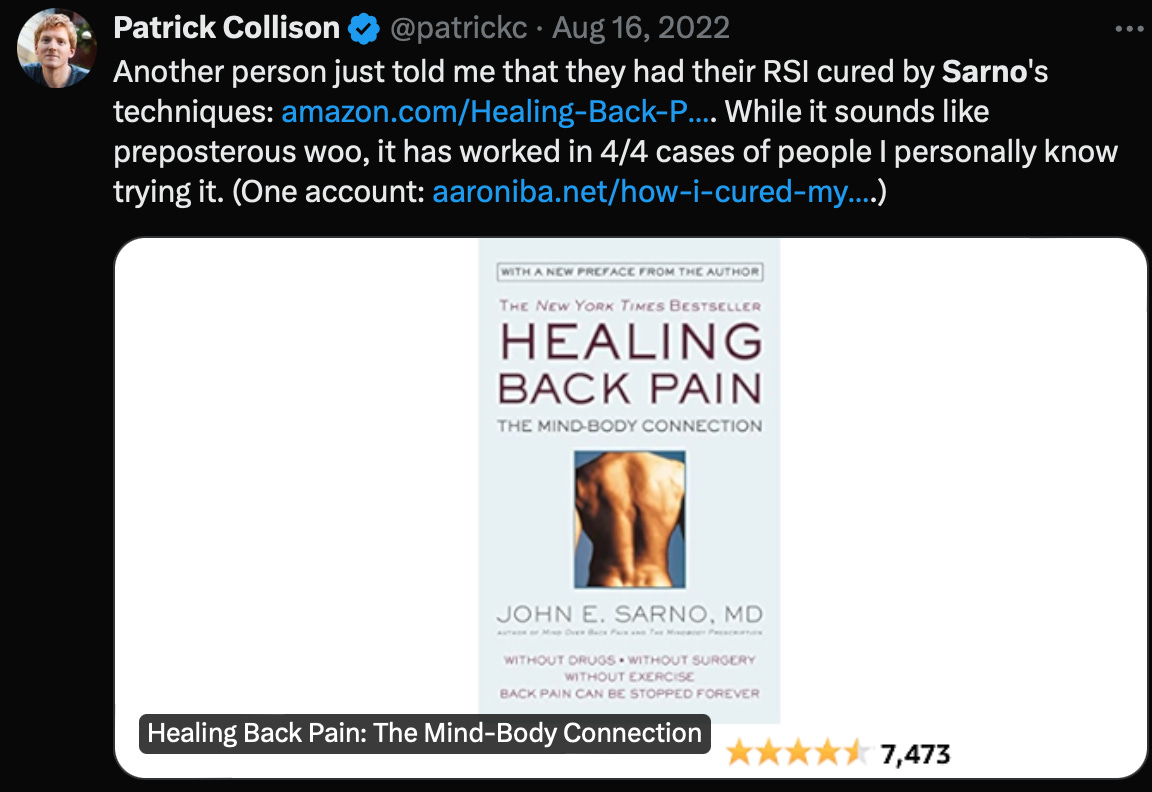Evidence Page
What is chronic pain and how can it be resolved
This page collects a broad range of evidence about chronic pain, and how it can be resolved. It includes scientific papers but also individual case studies from real people.
Pain resolution is possible without drugs or surgery
Different non-physical therapies can permanently relieve pain
People with chronic back pain (median ~10 years) experienced major reduction from education and sensory recalibration practices (4.1/10 pain to 1.2/10, placebo was 2.8/10). Treatment took 4 weeks and there was a mild regression 1 year after the follow up. (Ashar et al. 2021)
Psychophysiologic symptom relief therapy (PSRT) similarly shown to eliminate chronic pain in 64% of the participants in a pilot RCT at Harvard Medical School (Donnino et al., 2021)
Showing amputees a mirrored image of their limb reduces their phantom limb pain in many cases. (Moseley 2006, Finn et al. 2017)
Notable Individual Cases
Many of these cases refer specifically to the work of Dr John Sarno, a surgeon at NYU who popularized the idea that many forms of chronic pain were not due to structural damage in the body. What follows are the accounts of many individuals whose pain was resolved through altering their understanding of pain.
Other various interesting anecdotes:
Quora / Facebook co-founder Adam D’Angelo sponsored Donnino’s pilot study, which is inspired by John Sarno’s work.
Jim O’Shaughnessy (investor)
Celebrities Howard Stern and Larry David
You can find hundreds of compelling stories on internet forums, Amazon reviews, and YouTube.
Pain is not damage
Many People Have Damage Without Pain
In a landmark 1994 study of 98 pain-free people, over half had spinal disk abnormalities, showing that structural issues often exist without causing pain. (Jensen et al., 1994)
96% of pain-free young athletes showed spinal abnormalities including disc degeneration and arthropathy in detailed imaging. (Rajaswaran et al., 2014)
57% of pain-free adults aged 20-50 had cartilage defects in their hips, demonstrating that structural changes don’t necessarily cause pain. (Tresch et al., 2016)
23% of people without any shoulder pain had complete rotator cuff tears visible on imaging. (Tempelhof et al., 1999)
Many People Have Pain Without Damage
About 80% of amputees experience phantom limb pain, feeling intense pain in limbs that no longer exist, years after tissue has fully healed. (Limakatso et al. 2019)
Over 550 million people worldwide experience lower back pain that cannot be explained by any structural abnormality or disease. (World Health Organization)
Conditions like fibromyalgia demonstrate how chronic pain can exist without identifiable tissue damage. (Clauw, 2014)
A note on interpreting evidence
As many have noted, scientific studies take care to interpret. Many studies do not replicate. Indeed, the studies here are suggestive but not conclusive. Yet we still have to decide what to do about our condition. What do we do in light of this?
I suggest that, when the issue is your own health (rather than population-level guidelines), you will benefit from taking a different lens than the maximally skeptical scientist.
Rather than asking, “must I believe this?” and then discarding everything underneath that bar, I suggest a more helpful perspective is “could this be helpful?” — then collecting different interventions and prioritizing them based on their cost.
When we ask “could this be helpful?”, we can use anecdotes and informal reviews as evidence to form hypotheses. Then we can try the lowest-cost and highest-return experiments and see what empirically works in our own situations.
For more helpful additional resources for pain resolution, we have a list on our website here.
Of course, if you haven’t already, I would recommend also looking at the other resources on our site: Four Principles of Pain and especially the Pain Debugging Protocol. It provides a larger structure to understand how many of the other interventions fit into the resolution of pain.
Thanks to Ben Wheeler for pointing out our mistake in citing the Ashar 2022 paper.
Got anything to add? You can comment on this post or email Max at maxkshen[at]gmail. If you’d like to work with us directly to support your pain resolution, click here.






